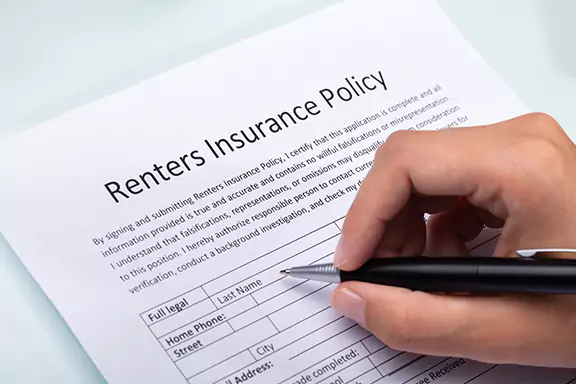Home and renters insurance are essential tools for protecting your financial well-being. Homeowners insurance provides coverage for the structure of your home, personal property, liability, and additional living expenses in case of damage or loss due to covered events. Renters insurance, while similar, is tailored for those who do not own their homes, offering extra coverage for personal belongings, liability, and temporary living expenses.
For newcomers and immigrants to the U.S., understanding these types of insurance is crucial. They help safeguard your investments, belongings, and peace of mind as you settle into a new environment. Without adequate coverage, unexpected events could lead to significant financial setbacks.
How Insurance Works in the U.S.: Basic Principles and Key Terms
Understanding how these policies function and the key terms involved is important for making informed decisions about home or even landlord and renters insurance.
Premiums: The regular payments made to keep your insurance policy active. Premiums are influenced by factors such as coverage limits, location, and the amount of your deductible.
Deductibles: The out-of-pocket amount you must pay before your insurance begins to cover a claim. For example, if your deductible is $500 and your claim is $2,000, you will pay $500, and your insurance will cover the remaining $1,500.
Coverage Limits: The maximum amount your insurance will pay for a covered loss. Selecting the right coverage limits ensures that your policy will adequately protect you in the event of major incidents.
Insurance policies in the U.S. come with detailed terms specifying what is and isn’t covered. Understanding these basics will help you make confident choices when selecting your insurance.
For more detailed explanations, see our guide on “Understanding Homeowners Insurance Terms and Jargon.”
Why New Immigrants Need Insurance
Newcomers to the U.S. often face unique challenges, including understanding an unfamiliar system of financial protection. Having insurance is especially vital for several reasons:
Protection Against Common Risks: The U.S. experiences various natural disasters such as floods, wildfires, and earthquakes. Additionally, theft and accidental property damage are common risks.
Legal Requirements: Many landlords require renters insurance as part of lease agreements, while mortgage lenders typically mandate homeowners insurance.
Financial Security: Insurance helps you recover from unexpected events without facing severe financial hardship.
For an in-depth look at how much renters insurance is, read “What is Renters Insurance and Why Do You Need It”.
Types of Coverage Available
Homeowners and renters insurance offer different types of coverage to fit various needs.
Homeowners Insurance Coverage includes:
Dwelling Coverage: Protects the structure of your home.
Personal Property Coverage: Covers items inside your home, such as furniture and electronics.
Liability Coverage: Offers protection if someone is injured on your property or if you cause damage to someone else’s property.
Additional Living Expenses (ALE): Helps pay for temporary housing and living costs if your home becomes uninhabitable due to a covered event.
Renters Insurance Coverage includes:
Personal Property Coverage: Renters insurance protects your belongings from events like theft, fire, and certain types of water damage.
Liability and Medical Payments Coverage: Protects you if someone is injured in your rental unit.
Additional Living Expenses (ALE): Covers costs for temporary accommodations if your rental becomes uninhabitable.
Explore more in our articles “Understanding Homeowners Insurance Terms: A Glossary for New Immigrants” and “Renters Insurance Terms: A Glossary for Newcomers.”

The Difference Between Renters Insurance and Landlord Insurance
Understanding the distinction between renters insurance and landlord insurance is essential for tenants and property owners as they provide essential protection against various risks that can cause significant financial loss or disruption.
While renters insurance is designed to help protect the tenant’s personal property and provides liability coverage, landlord insurance focuses on safeguarding the property owner’s investment.
What Does Renters Insurance Cover:
Covers the tenant’s personal belongings, such as electronics, furniture, and clothing.
Provides liability protection for the tenant if someone is injured within the rental unit.
Includes additional living expenses coverage to help the tenant find temporary housing if the rental becomes uninhabitable due to a covered event.
Landlord Insurance Coverage:
Covers the physical structure of the rental property, including repairs and damage caused by natural disasters, fire, or vandalism.
Provides liability coverage for the landlord in case a tenant or visitor is injured due to property-related issues (e.g., a slip-and-fall accident on icy stairs).
Does not cover the tenant’s personal property or provide living expense coverage for the tenant.
For newcomers renting a home, it’s important to understand that the landlord’s insurance will not cover your personal belongings. This makes renters insurance a crucial investment to protect your possessions and avoid unexpected expenses.
What are the Typical Amounts of Coverage for Homeowners and Renters Insurance
The amount of coverage available in a homeowner’s or renter’s insurance policy can vary depending on the specific policy and provider. However, understanding the general coverage amounts can help you decide what level of protection rental insurance you need.
Homeowners Insurance:
Dwelling Coverage: Often covers the cost to rebuild your home, which can range from $100,000 to $500,000 or more, depending on the value of the property.
Personal Property Coverage: Typically set at 50-70% of the dwelling coverage amount. For example, if your dwelling coverage is $300,000, your personal property coverage might be $150,000 to $210,000.
Liability Coverage: Usually starts at $100,000 but can be increased to $300,000 or more for additional peace of mind.
Additional Living Expenses (ALE): Typically provides 20% of the dwelling coverage, helping cover living costs if you need to move out temporarily due to a covered event.
Renters Insurance:
Personal Property Coverage: Commonly ranges from $10,000 to $50,000, depending on your needs and policy.
Liability Coverage: Often starts at $100,000, with the option to increase based on your preferences.
Additional Living Expenses (ALE): Usually a percentage of the personal property coverage and can vary by provider.
Assessing the value of your belongings and potential risks is essential to choosing adequate coverage. For homeowners, considering the full replacement cost of their home is key, while renters should evaluate the value of their personal property to ensure they have enough coverage.
How to File a Homeowners or Renters Insurance Claim
Filing a claim can seem daunting, but understanding the basic steps can make the process smoother. While detailed guides are available, here are the highlights for both homeowners and renters:
Document the Damage: Take photos or videos of the damaged property and gather receipts or proof of ownership if available.
Contact Your Insurance Provider: Notify your insurer immediately and provide the necessary details about the incident.
Complete the Claims Form: Fill out any required forms and submit them with your documentation.
Schedule an Inspection: An adjuster may be sent to assess the damage.
Receive Compensation: Once the claim is approved, you’ll receive payment based on your policy’s terms and coverage limits.
Understanding these steps can help you feel more prepared when the unexpected happens.
For more detailed information, How to File a Homeowners Insurance Claim: A Step-by-Step Guide
How to Choose the Right Insurance
Selecting the right insurance policy requires a thoughtful assessment of your needs. Here’s how to get started:
Assess Your Needs: Create an inventory of your belongings to understand how much coverage you need. Consider additional coverage options if you live in an area prone to natural disasters.
Budget Considerations: Balance the cost of premiums with your deductible. Higher deductibles can lower your monthly premiums but mean more out-of-pocket expenses if you need to make a claim.
Compare Policies: Use online comparison sites to evaluate different insurance options and find the best fit for your needs.
When discussing policies with insurers, ask detailed questions about policy terms, including exclusions and coverage limits, to ensure you fully understand what is included.
Find the Policy that Fits Your Needs
Home and renters insurance are key to protecting your property and ensuring financial stability in your new life. By taking the time to choose the right and affordable coverage, you can prevent major stress and expenses down the road.
For Homeowners
Save Money Today, Check Out – “Home Insurance Quotes Comparison: Finding the Best Deals Online“
For Renters
Protect Your Belongs – “Renters Insurance Quotes Comparison: The Best 8 Platforms to Help You Find the Right Coverage“

